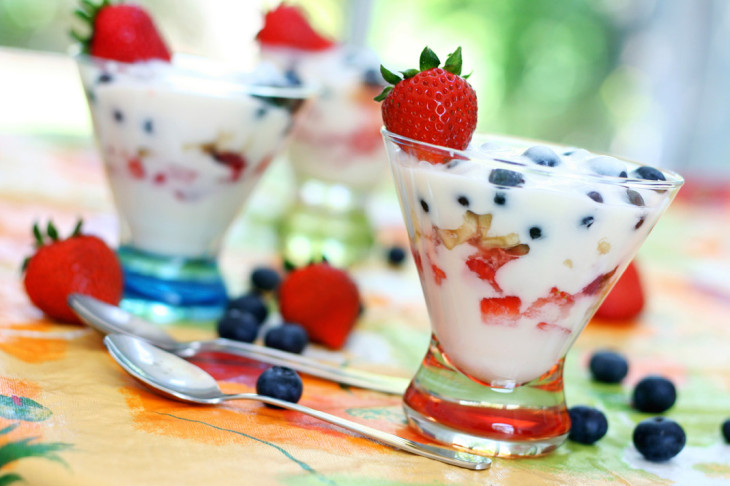As you get older proper nutrition becomes more important and you need to approach each decade with the proper fuel to live a healthy and fit life.
Important Nutrients in Your 40s
Fiber: Consuming fiber, particularly water-soluble fiber has been linked to a reduced risk of coronary heart disease. Some types of soluble fiber may help lower cholesterol. Soluble fiber is found in oat bran, barley, nuts, seeds, beans, lentils, peas, and some fruits (e.g. apples) and vegetables (e.g. potatoes and sweet potatoes). If you’re a woman over 40 but haven’t yet reached your 50th birthday, aim for a daily intake of 25 grams of fiber.
Calcium: Calcium helps regulate your blood pressure and together with vitamin D is important in lowering your risk for osteoporosis. “Women in their 40s should aim for at least 1,000 mg a day preferably from foods like low-fat milk, cheese and yogurt,” says Karen Ansel, MS, RDN, CDN. “Three servings of dairy usually provide all the calcium a woman in her 40’s needs. However, if you don’t eat that much dairy, a combination of food and supplements can also help.”
Vitamin D: Vitamin D helps your body absorb calcium. Calcium is one of the main building blocks of bone. Vitamin D is also important to keep your nerve, muscle, and immune systems running smoothly. You can get vitamin D through exposure to sunlight, vitamin D enriched foods and supplements. According to the National Institutes of Health, adults 19–70 years should consume 600 IU of vitamin D daily while adults 71 years and older need 800 IU. “Many health experts believe we need more and vitamin D metabolism varies tremendously from person to person,” says Ansel. “I recommend that women take a baseline supplement of 1,000 IU a day for three months and then have their vitamin D levels tested. If the numbers come back low, talk with your doctor about increasing the dose until your blood levels reach a healthy range.”
Important Nutrients in Your 50s
Fiber: Your digestive system slows down during this decade so make sure to include fiber in your diet and drink plenty of water. Now that you’re over 50 aim for 21 grams of fiber daily.
Calcium: Bone loss becomes more of a possibility after 50 so increase calcium to 1,200mg a day. “That’s the equivalent of 4 servings of dairy a day, which can seem like a tall order,” says Ansel. “If you just can’t eat that much dairy, a combination of calcium rich foods and supplements can also help.” Sources of calcium include milk, hard cheese, yogurt, canned fish like salmon or sardines, and calcium-fortified tofu or soy beverages. Continue with the recommendations for vitamin D listed above for women in their 40s.
Protein: As women get older, they need to consume enough protein to preserve muscle. “In addition to preventing muscle loss protein is also more slowly digested than any other nutrient so it keeps you full longer than fat or carbohydrates,” says Ansel. “Make sure you get enough by including protein rich foods like skinless white meat chicken, fish, Greek yogurt, part skim ricotta cheese, beans, edamame and eggs at every meal and snack.”
Vitamin B12: “We need stomach acid to convert vitamin B12 from food to a form that our bodies can absorb. After age 50 our stomachs don’t produce as much acid as they once did, making it hard for us to absorb this nutrient,” says Ansel. Also, any medicines you take to control the symptoms of GERD (gastroesophageal reflux disease), also known as acid reflux, slow the release of certain stomach acids and, therefore, interferes with the body’s absorption of vitamin B12. Check with your doctor to see if you need a B12 supplement. A deficiency in B12 can lead to severe nerve problems and anemia. Foods high in vitamin B12 include fortified cereals, red meat and, to a lesser extent, fish and poultry. Vitamin B12 helps your brain, blood, and nervous system.
Important Nutrients in Your 60s and Beyond
Follow the recommendations for your 50s for fiber, vitamin D, calcium and vitamin B12.
Hydration: About 55% of the average woman’s body is made of water. Women in their 60s sometimes don’t drink as much water as they need because as they get older their sensation of thirst diminishes. This can lead to dehydration. One way to see if you’re drinking enough water is to check your urine. If it’s clear or a pale yellow color, you’re drinking enough water but if it’s a dark yellow or amber, you need to hydrate soon. The Institute of Medicine recommends 2.7 liters (11.4 cups) daily but your water intake also depends on other factors such as how much you exercise and the temperature of your environment. “Carrying a water bottle with you where ever you go can make it easy to get the fluids you need to stay hydrated,” says Ansel. “You can also get fluids from coffee and tea. Water-rich foods are another easy way to sneak in fluids. Top picks include broth based soups and fruits and vegetables like lettuce, melons and tomatoes.”

